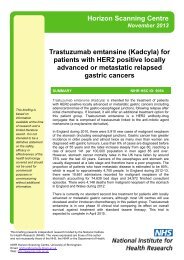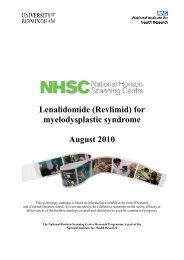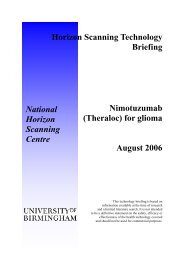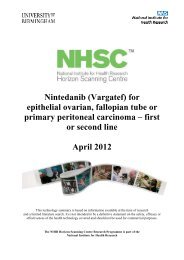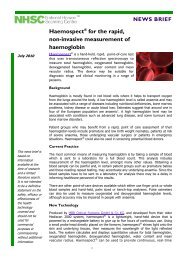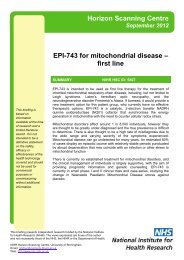Generex Oral-lyn™ (buccal insulin) for diabetes mellitus - National ...
Generex Oral-lyn™ (buccal insulin) for diabetes mellitus - National ...
Generex Oral-lyn™ (buccal insulin) for diabetes mellitus - National ...
You also want an ePaper? Increase the reach of your titles
YUMPU automatically turns print PDFs into web optimized ePapers that Google loves.
<strong>National</strong> Horizon Scanning Centre<br />
<strong>Generex</strong> <strong>Oral</strong>-lyn (<strong>buccal</strong> <strong>insulin</strong>)<br />
<strong>for</strong> <strong>diabetes</strong> <strong>mellitus</strong><br />
September 2007<br />
This technology summary is based on in<strong>for</strong>mation available at the time of research<br />
and a limited literature search. It is not intended to be a definitive statement on the safety, efficacy or<br />
effectiveness of the health technology covered and should not be used <strong>for</strong> commercial purposes.<br />
The <strong>National</strong> Horizon Scanning Centre Research Programme is part of the<br />
<strong>National</strong> Institute <strong>for</strong> Health Research
September 2007 <strong>National</strong> Horizon Scanning Centre<br />
News on emerging technologies in healthcare<br />
<strong>Generex</strong> <strong>Oral</strong>-lyn (<strong>buccal</strong> <strong>insulin</strong>) <strong>for</strong> <strong>diabetes</strong> <strong>mellitus</strong><br />
Target group<br />
• Type 1 and 2 <strong>diabetes</strong> <strong>mellitus</strong>.<br />
Technology description<br />
<strong>Generex</strong> <strong>Oral</strong>-lyn (<strong>buccal</strong> <strong>insulin</strong>, <strong>Oral</strong>in) is a liquid <strong>for</strong>mulation of short acting <strong>insulin</strong><br />
that is administered using <strong>Generex</strong>'s metered dosage aerosol applicator (RapidMist).<br />
<strong>Generex</strong> <strong>Oral</strong>-lyn is sprayed into the oral cavity, where the <strong>insulin</strong> is absorbed into the<br />
bloodstream through the mucosal lining.<br />
<strong>Generex</strong> <strong>Oral</strong>-lyn is likely to be used as both an add-on to current long-acting <strong>insulin</strong><br />
treatment and a substitute <strong>for</strong> injectable short acting <strong>insulin</strong>. If licensed, it may replace the<br />
need <strong>for</strong> injectable <strong>insulin</strong> throughout the day, requiring injections only <strong>for</strong> overnight<br />
<strong>insulin</strong> maintenance in patients with type 1 disease and <strong>for</strong> many with type 2 disease.<br />
Dosage is equivalent to current short-acting <strong>insulin</strong>. The <strong>for</strong>mulation can be stored <strong>for</strong> up<br />
to 3 months at room temperature if more that 15 months are left be<strong>for</strong>e product expiry.<br />
<strong>Generex</strong> <strong>Oral</strong>-lyn was launched in Ecuador in December 2005.<br />
Innovation and/or advantages<br />
<strong>Generex</strong> <strong>Oral</strong>-lyn is the first <strong>insulin</strong> agonist to be administered and absorbed through<br />
the <strong>buccal</strong> mucosa. Early trials suggest that the <strong>for</strong>mulation is more rapidly absorbed in<br />
the mouth with a more rapid onset of action than subcutaneous injected <strong>insulin</strong>. <strong>Generex</strong><br />
<strong>Oral</strong>-lyn may reduce the number of required injections, improving compliance, quality<br />
of life and reducing needlestick hazards.<br />
Developer<br />
<strong>Generex</strong> Biotechnology Corporation.<br />
Place of use<br />
Home care e.g. home dialysis<br />
� Secondary care e.g. general,<br />
non-specialist hospital<br />
General public e.g. over the<br />
counter<br />
Community or residential care e.g.<br />
district nurses, physio<br />
�Tertiary care e.g. highly specialist<br />
services or hospital<br />
Other:<br />
Availability, launch or marketing dates, and licensing plans:<br />
Phase III trials.<br />
NHS or Government priority area:<br />
This topic is relevant to the <strong>National</strong> Service Framework <strong>for</strong> Diabetes.<br />
� Primary care e.g. used by GPs or<br />
practice nurses<br />
Emergency care e.g. paramedic<br />
services, trauma care<br />
Relevant guidance<br />
• NICE clinical guideline: Diagnosis and management of type 1 <strong>diabetes</strong> in children,<br />
young people and adults. July 2004<br />
2<br />
1 .<br />
• NICE clinical guideline: Management of type 2 <strong>diabetes</strong> – managing blood glucose<br />
levels. September 2002 2 .<br />
• NICE clinical guideline in development: type 2 <strong>diabetes</strong> (update). Expected date of<br />
issue March 2008. This is an update of the following guidelines: type 2 <strong>diabetes</strong> –<br />
retinopathy, renal disease, blood glucose, management of blood pressure and blood<br />
lipids.
September 2007 <strong>National</strong> Horizon Scanning Centre<br />
News on emerging technologies in healthcare<br />
• Joint British Societies’ guidelines on prevention of cardiovascular disease in clinical<br />
practice. December 2005 3 .<br />
• SIGN – management of <strong>diabetes</strong>. Published November 2001. Review report 2005 4 .<br />
• NICE have published guidance on the use of inhaled <strong>insulin</strong> (2006) 5 ; glitazones<br />
(2003) 6 ; <strong>insulin</strong> pump therapy (2003) 7 ; <strong>insulin</strong> glargine (2002) 8 .<br />
Clinical need and burden of disease<br />
In England and Wales there were an estimated 2,018,000 people with <strong>diabetes</strong> in 2006 9 ,<br />
with type 2 <strong>diabetes</strong> accounting <strong>for</strong> more than 85% 10 . Type 1 <strong>diabetes</strong> is classically a<br />
disease of the young and is generally of rapid onset, but it can occur at any age. Type 2<br />
<strong>diabetes</strong> is characteristically a disease of the middle aged or elderly and usually begins<br />
subtly. Patients with <strong>diabetes</strong> have an average reduction in life expectancy of 5-10<br />
years 11 . Cardiovascular disease accounts <strong>for</strong> up to 60% of all deaths from <strong>diabetes</strong> and is<br />
the most common complication in Europeans with type 2 <strong>diabetes</strong> 12 . The risk of<br />
myocardial infarction and stroke is two to five times higher <strong>for</strong> individuals with type 2<br />
<strong>diabetes</strong> than in the general population 11 . For people with type 1 <strong>diabetes</strong>, there is a two-<br />
to threefold increase in risk of developing CHD and stroke in later life 3 . Further diabetic<br />
complications include nephropathy, retinopathy, foot ulceration and erectile dysfunction.<br />
Existing comparators and treatments<br />
There are three main types of <strong>insulin</strong> preparation given by subcutaneous injection:<br />
1. short-acting, which have a relatively rapid onset of action and are injected just<br />
be<strong>for</strong>e meals e.g. soluble <strong>insulin</strong>, <strong>insulin</strong> lispro, <strong>insulin</strong> aspart;<br />
2. intermediate acting, often given at bedtime e.g. isophane <strong>insulin</strong>, <strong>insulin</strong> zinc<br />
suspension;<br />
3. long-acting, which have a slower onset of action and act <strong>for</strong> long periods e.g.<br />
<strong>insulin</strong> glargine, <strong>insulin</strong> detemir.<br />
Short-acting <strong>insulin</strong> can also be given by continuous subcutaneous infusion using a<br />
portable infusion pump and by inhalation. For adults who have special visual needs, a<br />
confirmed and severe needle phobia or injection site problems, injection devices or<br />
needle-free systems may be used (including inhaled <strong>insulin</strong>).<br />
Efficacy and safety<br />
A phase III global multi-centre trial is ongoing. The company are unable to provide any<br />
in<strong>for</strong>mation.<br />
Trial Type 2 <strong>diabetes</strong>: placebo-controlled Type 1: Safety and efficacy<br />
Sponsor <strong>Generex</strong> Biotechnology Corporation <strong>Generex</strong> Biotechnology Corporation<br />
Status Conference abstract 13<br />
Conference abstract 14<br />
Location Israel Ecuador<br />
Design Randomised, double-blind, placebocontrolled<br />
Observational<br />
Participants in trial n= 26. Type 2 poorly controlled on once n=29 (24 adolescents, 5 young adult).<br />
daily <strong>insulin</strong> glargine and met<strong>for</strong>min. Type 1 <strong>diabetes</strong>. Stabilisation period of<br />
• In addition to regular treatment, 10 standard therapy <strong>for</strong> 28 days.<br />
minutes be<strong>for</strong>e meal:<br />
Split doses of <strong>Generex</strong> <strong>Oral</strong>-lyn<br />
o Group one: <strong>Generex</strong> <strong>Oral</strong>-lyn 3 replaced lunchtime injection of regular<br />
times a day<br />
o Group two: placebo 3 times a day<br />
• If glucose values above 12mmol/L<br />
be<strong>for</strong>e meal or be<strong>for</strong>e bedtime,<br />
<strong>insulin</strong> <strong>for</strong> 6 months.<br />
3
September 2007 <strong>National</strong> Horizon Scanning Centre<br />
News on emerging technologies in healthcare<br />
Follow-up<br />
additional puffs given.<br />
12 weeks 6 months<br />
Outcome Postprandial glucose, fasting glucose,<br />
HbA1c, fructosamine<br />
Safety and efficacy<br />
Key results Interim results at 8 weeks:<br />
21 subjects had good compliance. 8<br />
• no change in fasting glucose<br />
subjects had very poor compliance.<br />
• 15.4% reduction in postprandial Good compliance score: 51.9 (standard<br />
glucose in <strong>Generex</strong> <strong>Oral</strong>-lyn group deviation 14.97) vs. poor compliance<br />
(211.2mg±53.7 to 178.5mg±39.1) vs. score 14 (standard deviation 10.87) (P<<br />
3.5% elevation (202.7mg±60.1 to<br />
210.1mg±5.2) in placebo<br />
• Fructosamine 6.4% reduction in<br />
<strong>Generex</strong> <strong>Oral</strong>-lyn group vs 3.6% in<br />
placebo<br />
• HbA1c 6.6% reduction vs 3.4% in<br />
placebo<br />
0.001).<br />
Major adverse effects None stated<br />
Trial Type 1: Controlled<br />
Sponsor <strong>Generex</strong> Biotechnology Corporation<br />
Status Conference abstract 15<br />
Location Ecuador<br />
Design Cohort, controlled<br />
Participants in trial n=25. Type-1 <strong>diabetes</strong>. Stabilisation period of standard therapy.<br />
Control Group (n=11) twice daily isophane <strong>insulin</strong> + three times daily regular<br />
<strong>insulin</strong><br />
Treated Group (n=14) twice daily isophane <strong>insulin</strong> and three times daily prandial<br />
split doses of <strong>Generex</strong> <strong>Oral</strong>-lyn.<br />
Follow-up 99 days<br />
Outcomes Fructosamine, HbA1c<br />
Key results HbA1c: 7.3% to 6.8% in control group vs. 6.8 to 6.1% in <strong>Generex</strong> <strong>Oral</strong>-lyn group<br />
(P≤ 0.035)<br />
Fructosamine: 355.7 to 354.6 in control group vs. 313.2 to 319.2 in <strong>Generex</strong> <strong>Oral</strong>lyn<br />
group (not significant)<br />
Major adverse effects None stated<br />
Estimated cost and cost impact<br />
The cost of <strong>Generex</strong> <strong>Oral</strong>-lyn is currently unconfirmed. Any potential increase in<br />
treatment costs may be offset by savings from better health outcomes, potential reduced<br />
healthcare service use due to improved compliance and improved glycemic control.<br />
Potential or intended impact – speculative<br />
Patients<br />
� Reduced morbidity Reduced mortality or increased �Improved quality of life <strong>for</strong><br />
survival<br />
patients and/or carers<br />
Quicker, earlier or more accurate<br />
diagnosis or identification of disease<br />
Other: Non identified<br />
Services<br />
� Increased use: monitoring of<br />
change from subcutaneous <strong>insulin</strong><br />
Decreased use<br />
Service reorganisation required � Staff or training required<br />
Other: Non identified<br />
4
September 2007 <strong>National</strong> Horizon Scanning Centre<br />
Costs<br />
� Increased unit cost compared to<br />
alternative<br />
New costs:<br />
References<br />
Increased costs: more patients<br />
coming <strong>for</strong> treatment<br />
� Savings: improved compliance<br />
and control<br />
News on emerging technologies in healthcare<br />
Increased costs: capital<br />
investment needed<br />
Other:<br />
1 <strong>National</strong> Institute <strong>for</strong> Clinical Excellence. Clinical Guideline. Diagnosis and management of type 1 <strong>diabetes</strong> in<br />
children, young people and adults. July 2004<br />
2 <strong>National</strong> Institute <strong>for</strong> Clinical Excellence. Inherited Clinical Guideline G. Management of type 2 <strong>diabetes</strong>:<br />
Management of blood glucose. September 2002.<br />
3 Joint British Societies’ guidelines on prevention of cardiovascular disease in clinical practice. Heart. Volume<br />
91 Supplement V, December 2005<br />
4 Scottish Intercollegiate Guidelines Network. Management of Diabetes. 2001 (update 2005). Guideline number<br />
55.<br />
5 <strong>National</strong> Institute <strong>for</strong> Health and Clinical Excellence. Diabetes (type 1 and 2) – inhaled <strong>insulin</strong>. December<br />
2006.<br />
6 <strong>National</strong> Institute <strong>for</strong> Clinical Excellence. Guidance on the use of glitazones <strong>for</strong> the treatment of type 2<br />
<strong>diabetes</strong>. London. August 2003.<br />
7 <strong>National</strong> Institute <strong>for</strong> Clinical Excellence. Diabetes (type 1) - <strong>insulin</strong> pump therapy: The clinical effectiveness<br />
and cost effectiveness of <strong>insulin</strong> pump therapy. February 2003.<br />
8 <strong>National</strong> Institute <strong>for</strong> Clinical Excellence. Guidance on the use of long-acting <strong>insulin</strong> analogues <strong>for</strong> the<br />
treatment of <strong>diabetes</strong> – <strong>insulin</strong> glargine. London. <strong>National</strong> Institute <strong>for</strong> Clinical Excellence. December 2002.<br />
9 Diabetes UK. Reports and Statistics. Diabetes prevalence 2006. Hhttp://www.<strong>diabetes</strong>.org.uk/H. Accessed on<br />
8 th August 2007.<br />
10 <strong>National</strong> Institute For Health and Clinical Excellence. Final scope <strong>for</strong> type 2 <strong>diabetes</strong> guideline. June 2006.<br />
11 Marshall SM, Flyvbjerg A. Prevention and early detection of vascular complications of <strong>diabetes</strong>. BMJ 2006;<br />
333:475-480.<br />
12 Diabetes Mellitus - an update <strong>for</strong> healthcare professionals. British Medical Association 2004.<br />
13 Raz I, Dubinsky A, Kidron M et al. Addition of <strong>Oral</strong>in at meal-times in subjects with type-2 <strong>diabetes</strong><br />
maintained on glargine + met<strong>for</strong>min – a comparison with placebo. American Diabetes Association annual<br />
meeting 2005 (abstract number 2063-PO)<br />
14 Guevara-Aguirre J, Guevara-Aguirre M, Saavedra J et al. 6-Month Safety and Efficacy of Lunch-Time <strong>Oral</strong><br />
Insulin in Juvenile Type-1 DM Subjects Receiving Basal Glargine Insulin and Pre-Breakfast and Pre-Dinner<br />
S.C. Regular Insulin. American Diabetes Association annual meeting. 2007 (abstract number 2760-PO)<br />
15 Guevara-Aguirre J, Guevara-Aguirre M, Saavedra J. Comparison of Pre-prandial s.c. Regular Insulin vs<br />
Prandial <strong>Oral</strong> Insulin in Adult Type-1 DM Subjects Receiving Basal s.c. Twice Daily Isophane Insulin (NPH).<br />
American Diabetes Association annual meeting. 2007 (abstract number 0474-P)<br />
The <strong>National</strong> Institute <strong>for</strong> Health Research <strong>National</strong> Horizon Scanning Centre Research<br />
Programme is funded by the Department of Health.<br />
The views expressed in this publication are those of the author and not necessarily those of the<br />
NHS, the NIHR or the Department of Health<br />
The <strong>National</strong> Horizon Scanning Centre,<br />
Department of Public Health and Epidemiology<br />
University of Birmingham, Edgbaston, Birmingham, B15 2TT, England<br />
Tel: +44 (0)121 414 7831 Fax +44 (0)121 414 2269<br />
www.pcpoh.bham.ac.uk/publichealth/horizon<br />
5



